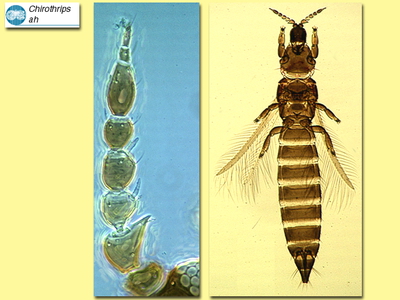Figures
Fig. 1 Antenna, head, thorax and abdomen
Fig. 2 Head and pronotum
Fig. 3 Fore and hind wing
Fig. 4 Meso and metanotum with first abdominal tergite
Fig. 5 Tergite IV and V, and sternites III and IV of a male with pore plates
Species
Chirothrips ah Girault
Biology
In common with other members of the genus this species breeds only in the flowers of grasses. Nothing is known of its host specificity, but adults have been taken from Hypparhenia and Stipa species.
Distribution
Widespread in southern Africa and northern Australia; also recorded from New Guinea and New Caledonia.
Recognition
Body and legs brown, head darkest, tarsi and antennal segment III yellowish; forewing light brown. Head smaller than pronotum, projecting lightly in front of eyes. Antennae 8-segmented, segment I wider than long, II asymmetric with external margin produced into a recurved point, III scarcely longer than wide, III & IV with sense cone simple, VII+VIII shorter than VI. Pronotum trapezoidal, wider at posterior angles, with 2 pairs of posteroangular setae and 4 or 5 pairs of small posteromarginal setae. Metanotum with median pair of setae longer than lateral pair and slightly longer than distance between their bases. Mesothoracic endofurca well-developed with broad lateral lobes. Forewing slender, apex acute; first vein with 2 widely spaced setae in distal half, second vein with 5 widely spaced setae. Tarsi all 2-segmented. Tergites II-IV with at least 15 small translucent lobes on posterior margin, antecostal ridge simple. Sternites with about 15 sharply pointed lobes on posterior margin; ovipositor well developed. Male similar to female, wings fully developed; sternites III-VII with a large circular glandular area, tergite IX without any strong setae.
Related species
About 60 species are now placed in this genus, and C. ah differs from many of these in having the ovipositor well developed, the males fully macropterous, the median pair of metanotal setae longer than the lateral pair, and antennal segment II hooked at the apex.






